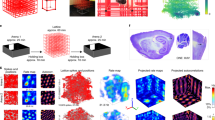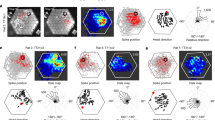Abstract
The subjective sense of space may result in part from the combined activity of place cells in the hippocampus and grid cells in posterior cortical regions such as the entorhinal cortex and pre- and parasubiculum. In horizontal planar environments, place cells provide focal positional information, whereas grid cells supply odometric (distance measuring) information. How these cells operate in three dimensions is unknown, even though the real world is three-dimensional. We investigated this issue in rats exploring two different kinds of apparatus: a climbing wall (the 'pegboard') and a helix. Place and grid cell firing fields had normal horizontal characteristics but were elongated vertically, with grid fields forming stripes. It seems that grid cell odometry (and by implication path integration) is impaired or absent in the vertical domain, at least when the rat itself remains horizontal. These findings suggest that the mammalian encoding of three-dimensional space is anisotropic.
This is a preview of subscription content, access via your institution
Access options
Subscribe to this journal
Receive 12 print issues and online access
$209.00 per year
only $17.42 per issue
Buy this article
- Purchase on Springer Link
- Instant access to full article PDF
Prices may be subject to local taxes which are calculated during checkout





Similar content being viewed by others
References
Burgess, N. Spatial cognition and the brain. Ann. NY Acad. Sci. 1124, 77–97 (2008).
Moser, E.I., Kropff, E. & Moser, M.B. Place cells, grid cells, and the brain's spatial representation system. Annu. Rev. Neurosci. 31, 69–89 (2008).
Hafting, T., Fyhn, M., Molden, S., Moser, M.B. & Moser, E.I. Microstructure of a spatial map in the entorhinal cortex. Nature 436, 801–806 (2005).
Boccara, C.N. et al. Grid cells in pre- and parasubiculum. Nat. Neurosci. 13, 987–994 (2010).
Barry, C., Hayman, R., Burgess, N. & Jeffery, K.J. Experience-dependent rescaling of entorhinal grids. Nat. Neurosci. 10, 682–684 (2007).
O'Keefe, J. & Nadel, L. The Hippocampus as a Cognitive Map (Clarendon Press, 1978).
Jeffery, K. Navigating in a 3D world. in Animal Thinking: Contemporary Issues in Comparative Cognition (eds. Menzel, R. & Fischer, J.) (MIT Press, in the press).
Hartley, T., Burgess, N., Lever, C., Cacucci, F. & O'Keefe, J. Modeling place fields in terms of the cortical inputs to the hippocampus. Hippocampus 10, 369–379 (2000).
Skaggs, W.E., McNaughton, B.L., Gothard, K.M. & Markus, E.J. An information-theoretic approach to deciphering the hippocampal code. Adv. Neural Inf. Process. Syst. 5, 1031–1037 (1993).
Jeffery, K.J. Integration of the sensory inputs to place cells: what, where, why, and how? Hippocampus 17, 775–785 (2007).
Knierim, J.J. & McNaughton, B.L. Hippocampal place-cell firing during movement in three-dimensional space. J. Neurophysiol. 85, 105–116 (2001).
Knierim, J.J., McNaughton, B.L. & Poe, G.R. Three-dimensional spatial selectivity of hippocampal neurons during space flight. Nat. Neurosci. 3, 209–210 (2000).
Jeffery, K.J., Anand, R.L. & Anderson, M.I. A role for terrain slope in orienting hippocampal place fields. Exp. Brain Res. 169, 218–225 (2006).
Derdikman, D. et al. Fragmentation of grid cell maps in a multicompartment environment. Nat. Neurosci. 12, 1325–1332 (2009).
Nitz, D.A. Path shape impacts the extent of CA1 pattern recurrence both within and across environments. J. Neurophysiol. 105, 1815–1824 (2011).
Stackman, R.W., Tullman, M.L. & Taube, J.S. Maintenance of rat head direction cell firing during locomotion in the vertical plane. J. Neurophysiol. 83, 393–405 (2000).
McNaughton, B.L., Battaglia, F.P., Jensen, O., Moser, E.I. & Moser, M.B. Path integration and the neural basis of the 'cognitive map'. Nat. Rev. Neurosci. 7, 663–678 (2006).
O'Keefe, J. & Burgess, N. Dual phase and rate coding in hippocampal place cells: theoretical significance and relationship to entorhinal grid cells. Hippocampus 15, 853–866 (2005).
Fuhs, M.C. & Touretzky, D.S. A spin glass model of path integration in rat medial entorhinal cortex. J. Neurosci. 26, 4266–4276 (2006).
Tafforin, C. & Campan, R. Ethological experiments on human orientation behavior within a three-dimensional space—in microgravity. Adv. Space Res. 14, 415–418 (1994).
Leutgeb, J.K., Leutgeb, S., Moser, M.B. & Moser, E.I. Pattern separation in the dentate gyrus and CA3 of the hippocampus. Science 315, 961–966 (2007).
Sargolini, F. et al. Conjunctive representation of position, direction, and velocity in entorhinal cortex. Science 312, 758–762 (2006).
Acknowledgements
The work was supported by grants from the Wellcome Trust to K.J.J., the European Commission Framework 7 ('Spacebrain') to K.J.J. and Axona Ltd, and a National Science Foundation grant (no. IOS-0725001) to A.A.F. We thank E. Kelemen for help designing and M. Shkop for constructing the helical track, E. Leeper for building the pegboard arena, M. Witter for advice on histology and C. Barry and F. Cacucci for comments on the manuscript.
Author information
Authors and Affiliations
Contributions
R.H., M.A.V. and A.J. contributed equally to the work. R.H. and M.A.V. implanted electrodes, recorded and analyzed the bulk of the data and wrote most of the Online Methods. A.J. recorded the bulk of the pegboard data and contributed analysis and the Online Methods. A.A.F. conceived the helical track, oversaw its construction and advised on data analysis and interpretation. K.J.J. conceived and gained funding for the overall research program, designed the pegboard and oversaw its construction, supervised the data collection and analysis and wrote the Introduction and Discussion.
Corresponding author
Ethics declarations
Competing interests
K.J.J. is a non-shareholding co-director of Axona Ltd., which is owned by a family member.
Supplementary information
Supplementary Text and Figures
Supplementary Figures 1–13 and Supplementary Results (PDF 4791 kb)
Rights and permissions
About this article
Cite this article
Hayman, R., Verriotis, M., Jovalekic, A. et al. Anisotropic encoding of three-dimensional space by place cells and grid cells. Nat Neurosci 14, 1182–1188 (2011). https://doi.org/10.1038/nn.2892
Received:
Accepted:
Published:
Issue Date:
DOI: https://doi.org/10.1038/nn.2892
This article is cited by
-
Can rats and ants exchange information between the horizontal and vertical domains?
Animal Cognition (2023)
-
Brain works principle followed by neural information processing: a review of novel brain theory
Artificial Intelligence Review (2023)
-
A small step for rats alters spatial behavior: rats on a bi-level arena explore each level separately
Animal Cognition (2023)
-
The place cell activity in three-dimensional space generated by multiple grid cell inputs
Nonlinear Dynamics (2022)
-
Locally ordered representation of 3D space in the entorhinal cortex
Nature (2021)



